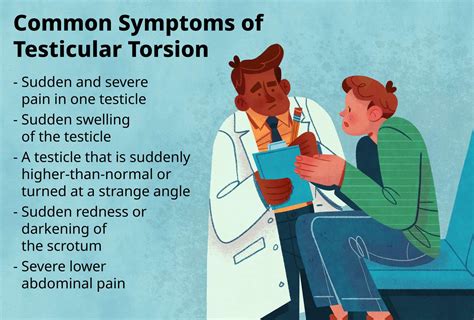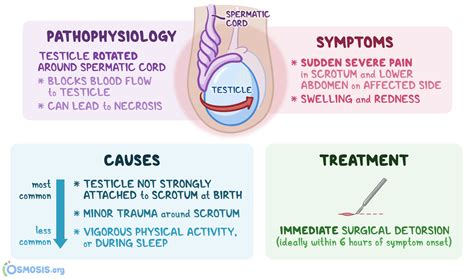Intro
Learn about testicular torsion surgery, a medical emergency requiring prompt treatment. Discover the causes, symptoms, and treatment options for this painful condition. Understand the importance of timely intervention to prevent infertility and other complications, and explore the surgical procedures used to restore testicular function and alleviate pain.
Testicular torsion is a serious medical condition that requires immediate attention. It occurs when the spermatic cord, which provides blood flow to the testicle, becomes twisted, cutting off the blood supply. This can lead to permanent damage or even loss of the testicle if left untreated. Testicular torsion surgery is a common treatment option for this condition.

Understanding the causes and symptoms of testicular torsion is crucial for prompt diagnosis and treatment. In this article, we will delve into the world of testicular torsion, exploring its causes, symptoms, and treatment options, including surgery.
Causes of Testicular Torsion
Testicular torsion can occur at any age, but it is most common in adolescents and young adults. The exact cause of testicular torsion is not always clear, but several factors can increase the risk:
- Anatomical abnormalities: Some people may have a condition called a "bell-clapper" deformity, where the testicle is not properly attached to the scrotum, making it more prone to twisting.
- Trauma: A sudden injury to the testicles, such as a kick or a fall, can cause the spermatic cord to twist.
- Cold temperatures: Exposure to cold temperatures can cause the testicles to contract, which can lead to torsion.
- Physical activity: Engaging in strenuous physical activity, especially sports that involve rapid changes of direction, can increase the risk of testicular torsion.
Symptoms of Testicular Torsion
The symptoms of testicular torsion can be severe and sudden. They may include:
- Severe pain: A sudden, severe pain in the testicle, scrotum, or groin area.
- Swollen testicle: The affected testicle may become swollen and tender to the touch.
- Nausea and vomiting: Some people may experience nausea and vomiting due to the intense pain.
- Fever: A low-grade fever may be present in some cases.
Diagnosis of Testicular Torsion
Diagnosing testicular torsion requires a combination of physical examination, medical history, and imaging tests. A doctor may perform the following:
- Physical examination: A thorough examination of the scrotum, testicles, and groin area to check for tenderness, swelling, and other signs of torsion.
- Medical history: A review of the patient's medical history to identify any potential risk factors or underlying conditions.
- Imaging tests: Ultrasound or other imaging tests may be ordered to confirm the diagnosis and rule out other conditions.

Treatment Options for Testicular Torsion
Treatment for testicular torsion depends on the severity of the condition and the length of time the testicle has been twisted. The goal of treatment is to restore blood flow to the testicle and prevent permanent damage.
- Manual detorsion: In some cases, a doctor may attempt to manually untwist the spermatic cord to restore blood flow.
- Surgery: Testicular torsion surgery, also known as orchiopexy, is often necessary to restore blood flow and prevent further damage.
Testicular Torsion Surgery
Testicular torsion surgery is usually performed under general anesthesia. The procedure involves:
- Making an incision: A small incision is made in the scrotum to access the affected testicle.
- Untwisting the spermatic cord: The spermatic cord is carefully untwisted to restore blood flow to the testicle.
- Fixing the testicle: The testicle is then fixed in place to prevent further twisting.

Recovery and Complications
Recovery from testicular torsion surgery typically takes several weeks. Patients may experience:
- Pain and swelling: Mild pain and swelling in the scrotum and groin area.
- Bruising: Bruising in the scrotum and groin area.
- Limited mobility: Patients may need to avoid strenuous activities and heavy lifting for several weeks.
Complications of testicular torsion surgery are rare but can include:
- Infection: As with any surgical procedure, there is a risk of infection.
- Bleeding: Excessive bleeding during or after surgery.
- Testicular atrophy: In some cases, the testicle may not survive due to prolonged lack of blood flow.
Prevention and Self-Care
While testicular torsion cannot be completely prevented, there are steps that can be taken to reduce the risk:
- Wearing protective gear: Wearing protective gear, such as a cup, during sports and physical activities.
- Avoiding trauma: Avoiding sudden impacts or trauma to the testicles.
- Seeking medical attention: Seeking medical attention immediately if symptoms of testicular torsion occur.

Conclusion
Testicular torsion is a serious medical condition that requires prompt attention. Understanding the causes and symptoms of testicular torsion can help individuals seek medical attention quickly, reducing the risk of permanent damage or loss of the testicle. Testicular torsion surgery is a common treatment option, and with proper care and recovery, individuals can make a full recovery.
We encourage you to share your thoughts and experiences with testicular torsion in the comments below. If you have any questions or concerns, please don't hesitate to ask.
What is testicular torsion?
+Testicular torsion is a medical condition where the spermatic cord becomes twisted, cutting off blood flow to the testicle.
What are the symptoms of testicular torsion?
+The symptoms of testicular torsion include severe pain, swollen testicle, nausea and vomiting, and fever.
How is testicular torsion treated?
+Treatment for testicular torsion depends on the severity of the condition and may include manual detorsion or surgery.
